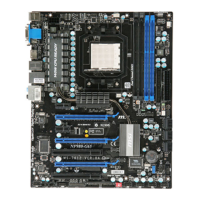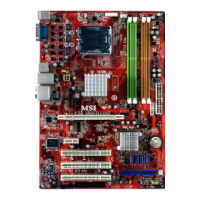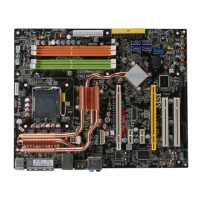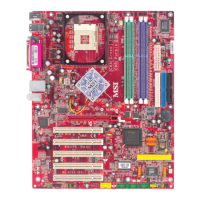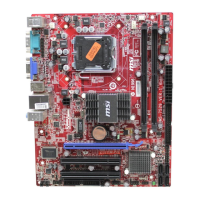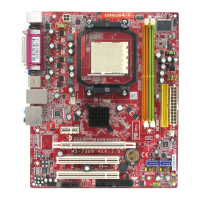
Do you have a question about the MSI NF750-G55 - Motherboard - ATX and is the answer not in the manual?
| Form Factor | ATX |
|---|---|
| Memory Slots | 4 |
| Maximum Memory | 16 GB |
| Graphics Interface | PCIe x16 |
| Chipset | NVIDIA nForce 750a SLI |
| Socket | AM2+ |
| Storage Interface | 6 x SATA 3Gb/s |
| USB Ports | 12 x USB 2.0 (8 on back panel, 4 via internal headers) |
| Audio | Realtek ALC888S |
| Expansion Slots | 2 x PCIe x16, 2 x PCI |
Detailed technical specifications of the mainboard, including CPU, chipset, memory, and I/O.
Diagram and labeling of key components and connectors on the mainboard for easy identification.
List of items included in the product package for user verification.
Visual guide identifying major onboard components and their locations for easy reference.
Step-by-step instructions for installing the CPU and its associated cooling solution securely.
Guide on how to properly insert DDR3 memory modules into the DIMM slots.
Details on connecting the ATX 24-pin and 4-pin power connectors for system power.
Description and function of all I/O ports located on the computer's rear panel.
Explanation of the onboard audio connectors and their specific audio output/input functions.
Details on connecting storage devices, front panel headers, fans, and other internal components.
Functionality and usage of onboard switches like OC switch and buttons like power.
Information on installing expansion cards in PCI Express and PCI slots.
Explanation of NVIDIA SLI and Hybrid SLI for multi-GPU setups.
Understanding the meaning of onboard LEDs, particularly APS LEDs for power phases.
Instructions on how to access the BIOS Setup utility during system startup.
Explanation of keys used for navigating and making changes within the BIOS utility.
Overview of the primary categories and functions available in the BIOS setup menu.
Configuration of basic system settings like date, time, and IDE/SATA devices.
Setup options for enhanced system features, boot behavior, and peripheral control.
Configuration settings for onboard devices such as USB, LAN, and HD Audio.
Settings for managing system power states, sleep modes, and monitoring hardware status.
Advanced settings for CPU and memory frequency, voltage, and overclocking.
Options for setting BIOS passwords and managing user configuration settings.
Loading system defaults for stability or optimal performance and exiting the setup.
Step-by-step guide to install the Realtek HD audio driver for full functionality.
Overview of the Realtek HD Audio Manager for audio setup and customization.
Selecting and applying various sound environments and effects for audio playback.
Customizing audio output with a 10-band equalizer for personalized sound profiles.
Adjusting volume levels for different audio channels and streams.
Managing audio playback streams and recording input channels.
Configuring multi-channel audio output and speaker connections.
Details on using the S/PDIF interface for digital audio transfer.
Configuring microphone input with noise suppression and echo cancellation.
Explanation of Redundant Array of Independent Disks technology and its benefits.
Comprehensive guide to setting up RAID arrays from BIOS to OS.
Procedure for installing NVIDIA RAID drivers during Windows XP/Vista setup.
Guide to installing the NVIDIA MediaShield software for RAID management.
Steps to initialize and format RAID arrays within the Windows operating system.
Navigating the NVIDIA Control Panel for storage management and RAID operations.
Methods to launch the Overclocking Center utility from desktop or start menu.
Accessing hardware information for motherboard, CPU, and PCI devices.
Introduction to the DOT utility for system performance tuning.
Using pre-defined profiles for different operating environments in DOT.
Fine-tuning CPU, voltage, fan speed, and system parameters for overclocking.
Setting alerts for critical CPU temperatures and fan speeds.
Managing custom overclocking profiles for future use.
